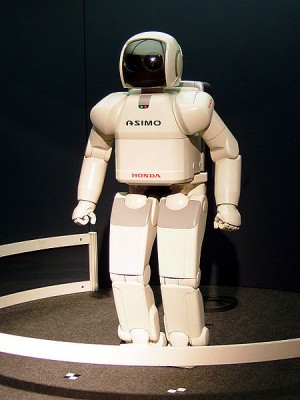Roblog is a weekly column dedicated to understanding the world of robotics. If science fiction is right and the impending robot apocalypse is real, it can’t hurt to be prepared. Come back every Wednesday for a new blog of robot rants.

When people make robots with fingers, feet or faces, I can’t help but wonder if they are looking forward to a robot apocalypse. A convincing enough humanoid robot could infiltrate society without us even noticing! It might be able to open doors, climb stairs or use tools. Despite these nightmare-inducing possibilities, some manufacturers continue to make humanoid robots with highly developed skills that are no longer utilized by humans alone. Between all the humanoid robotic technology in the field, it’s rather impressive (and terrifying) how far robots have come toward fitting in.
Boston Dynamics is the biggest name in spooky robot technology of all types. Their Cheetah robot is incredible, but it can’t yet do much more than run straight on flat ground. The most recent iteration of their humanoid robot, Petman, however, has a wide variety of human-like skills. Petman revolutionized the humanoid robotics world with its heel-to-toe walking pattern and realistic arm movements. Made for the military to test clothing for soldiers, it can do lots of actions like twist, kneel and even do push-ups. Now, Petman is more agile than ever and can climb stairs. With its huge set of physical abilities, Petman is one of the more impressive humanoid robots that exists today.
Theoretically, if Petman was combined with a robotic face and hands, robots would be well on their way to human impersonation. One robotic face, made several years ago by the National Institute of Advanced Industrial Science and Technology (AIST), remains one of the most realistic that exists today. HRP-4c is modeled to look like a young Japanese woman and can breathe, blink, talk and sing in a surprisingly human-like way. Pair those technologies with something like the robotic hand technology developed in the DEXMART project and you would have a robot that could function quite like a human. During the project, researchers at Saarland University created a reasonable sized human hand that had the ability to pick up and hold an egg.
Granted, no such super humanoid robot exists, yet. If DARPA’s $2 million contest produces any winners, however, that could change. The same Defense Advanced Research Projects Agency (DARPA) that funds many of Boston Dynamics projects is holding a Robotics Challenge to challenge robot manufacturers to make a robot that could respond to disaster scenarios in environments engineered for humans. The goal is to make robots that can do human tasks like using tools or driving vehicles. Based on DARPA’s already impressive project list, this challenge could result in robots more human-like than ever. Let’s just hope these robots stick to helping fix disasters and not to using their human skills to cause trouble instead.


2 Comments on “Roblog: Humanoid Robots are Too Human for Comfort”